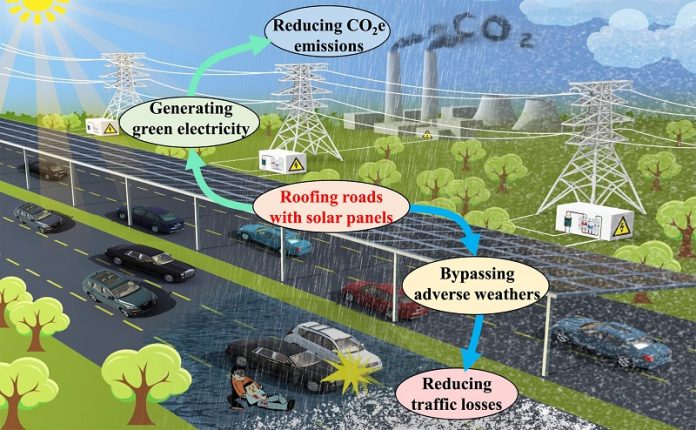
Imagine driving down a highway with solar panels overhead, generating electricity and shielding you from rain or snow.
This futuristic idea could drastically reduce carbon emissions and improve road safety, according to new research.
A recent study suggests that covering the world’s highways with solar panels could cut global carbon dioxide emissions by 28%.
This would reduce the need for fossil fuels significantly.
The study, published in the journal Earth’s Future, envisions a vast network of solar panels elevated above highways, producing electricity and protecting cars from bad weather.
“There are some pilot programs for highway solar roofs, but not on the scale we imagined,” said Ling Yao, the lead author of the study and a scientist at the Chinese Academy of Sciences.
“Covering Earth’s highways with solar roofs could generate 17.58 petawatt-hours of electricity per year, more than 60% of the world’s total electricity consumption in 2023.”
Innovative solutions like this are necessary to meet global climate goals. Solar panels have become more affordable, and creative projects like Yao’s could help the world shift to sustainable energy.
Yao got the idea while driving over an overpass. He thought, “The roads are connected like a network. Why not turn them into a network of photovoltaics?” By using the already-developed land of highways to generate electricity, we could reduce our dependence on greenhouse gas-producing energy.
There are more than 3.2 million kilometers (1.9 million miles) of highways on Earth. If we covered them with solar panels, we could significantly cut carbon emissions. While solar-roofed parking lots are becoming common, photovoltaic-paved and -roofed roads are still new. Some countries have small pilot projects, but long stretches of solar-covered highways are not yet a reality.
The researchers calculated the costs and benefits of building and maintaining a network of solar panels over highways worldwide. They based their analysis on standard polysilicon photovoltaic panels, tilted at 10 degrees. They found that installing solar roofs over highways would require 52.3 billion solar panels. These panels could generate 17,578 terawatt-hours of electricity per year, more than four times the annual energy output of the United States. Adding solar roofs to major arterial roads could produce an additional 13,570 terawatt-hours per year.
Most of these solar installations would be near densely populated areas with many highways, like eastern China, western Europe, and the U.S. East Coast. This global network could replace the equivalent of 9.66 gigatons of fossil fuel-generated carbon dioxide per year, or about two-thirds of the U.S.’s greenhouse gas emissions in 2022.
Solar highway roofs could also make driving safer. The study estimates they could reduce worldwide traffic deaths by 10.8% by protecting drivers and roads from rain and snow, especially in areas with high precipitation. This would also lower the economic costs of traffic accidents.
However, there are challenges. Solar roofs over highways could cost up to four times more than ground-based arrays, and maintaining them could be tricky, including the task of cleaning billions of panels.
Despite these challenges, Yao is optimistic. He believes that successful small-scale projects could lead to wider adoption. He sees long, flat highways, like those in the southwestern United States, as ideal locations for solar roofs.
“Putting this idea into practice is the best way to show that it works,” Yao said.



